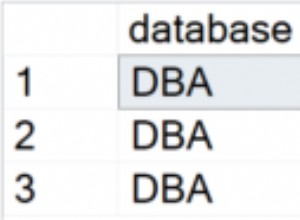Una forma es usar exists predicado con una subconsulta correlacionada que verifica que el símbolo específico tenga más de un precio.:
select * from table1 t
where exists (
select 1
from table1
where symbol = t.symbol
and price <> t.price);
Esto devolvería:
| Date | Type | Symbol | Price |
|------------------------|------|-----------|--------|
| June, 30 1995 02:00:00 | gaus | 313586U72 | 109.25 |
| June, 30 1995 02:00:00 | gbus | 313586U72 | 108.94 |
| June, 30 1995 02:00:00 | agus | SRR | 10.25 |
| June, 30 1995 02:00:00 | lcus | SRR | 0.45 |
| July, 01 1995 02:00:00 | gaus | 313586U72 | 109.25 |
| July, 01 1995 02:00:00 | gbus | 313586U72 | 108.94 |
Editar:inspirado en la respuesta inteligente de Gordon Linoff, otra opción podría ser usar avg() como una función de ventana:
select Date, Type, Symbol, Price
from (
select Date, Type, Symbol, Price, avg = avg(price) over (partition by symbol)
from table1) a
where avg <> price;
Editar:con una verificación para asegurarse de que solo se devuelvan los duplicados en la misma fecha:http:/ /www.sqlfiddle.com/#!6/29d67/1




